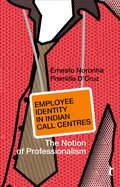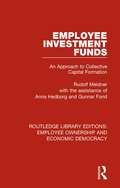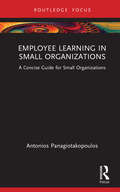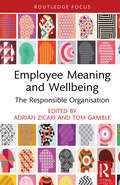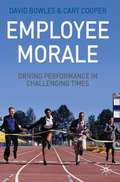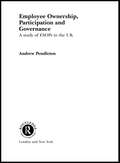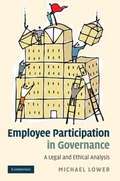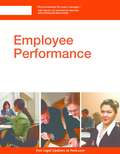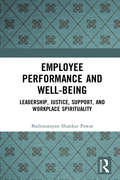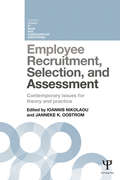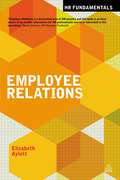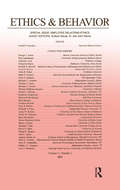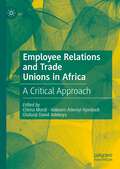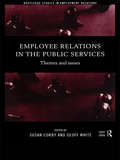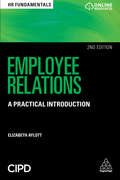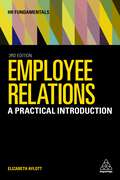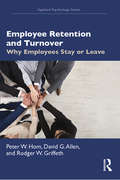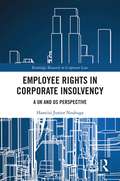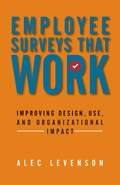- Table View
- List View
Employee Identity in Indian Call Centres: The Notion of Professionalism (Response Books)
by Ernesto Noronha Premilla D′CruzBased on a series of qualitative inquiries exploring employee experiences of work in international facing call centres in Mumbai and Bangalore, India, this book presents the lived experience of call centre agents, coupled with managers’ perspectives and trade unionists’ viewpoints. The book underscores how employee identity is defined by the notion of professionalism. Inculcated in agents by employer organizations, professional identity is invoked as a means of gaining employee commitment to the realization of organizational goals in a bid to ensure competitive advantage. While professional identity is associated with a host of privileges, it not only results in agents justifying and complying with organizational requirements and absorbing job-related strain but also precludes agents’ engagement with collectivist endeavours aimed at representing and protecting their interests, causing the nascent trade union movement in this sector to reinvent itself. While employer organizations thus rely on the notion of professionalism to achieve organizational ends, they admit to discrepancies in the enactment of professionalism, indicating the presence of rhetoric. Providing new and holistic insights gained via rigorous academic research, this book is of value to HR and OB professionals and scholars, industrial relations experts, sociologists, psychologists and trade unionists, as well as readers interested in India’s ITES-BPO sector.
Employee Investment Funds: An Approach to Collective Capital Formation (Routledge Library Editions: Employee Ownership and Economic Democracy #5)
by Rudolf Meidner Anna Hedborg Gunnar FondOriginally published in 1978. The present study had grown out of the deliberations of wage policy at the 1971 Congress of LO, the Swedish Confederation of Trade Unions. For many years the LO had pursued a policy of solidarity in wage policy – a policy which sought to relate pay to the nature of the work which an employee carried out, and not to the capacity or ability of the employer to pay. Several issues related to this policy are explored. This study was extremely controversial when first published in Sweden, and will therefore be of great interest to students of economic history and democracy.
Employee Learning in Small Organizations: A Concise Guide for Small Organizations
by Antonios PanagiotakopoulosEmployee Learning in Small Organizations provides a clear, concise and comprehensive analysis of the theory and practice of employee learning in micro- and small enterprises. The book offers easy-to-digest theory alongside practical application advice on how to effectively engage with employee learning in small businesses. Rather than see small firms as scaled-down examples of large organizations, the book highlights the different constraints and challenges that smaller business face. Topics include the wider framework of the political economy of skills, the impact of human resource development on small firms, employee learning, and the relationship with other human resource activities. This is a short accessible guide suitable for anyone interested in employee learning and small business human resources.
Employee Meaning and Wellbeing: The Responsible Organisation (Routledge COBS Focus on Responsible Business)
by Adrián Zicari Tom GambleThe Covid-19 pandemic sparked a latent desire for a more balanced, more meaningful and freer approach to work for millions of employees throughout the world. Growing interest in responsible business, in addition to the influence of the UN SDGs and inclusive growth, have also in many ways shifted the balance of power – or at least choice – to the employee. Sensitive to work-life balance, aware of the effects of overwork and short-term profit seeking, seeking meaning in their companies and jobs, employee demands have placed a huge strain on corporations caught between keeping to traditional ways of control and performance objectives though aware of the need to retain talent and create flexible solutions in order to reach their financial and production goals.In this book, leading academics, researchers, and practitioners in the field of CSR, management, leadership, and human resources from the 12 schools and corporate partners of the Council on Business & Society offer their latest cutting-edge research to explore how both employees and their organisations can reach win–win agreement in the working relationship. Meaning and mission are covered, as well as spirituality and purpose. Negative workplace practices leading to employee mental and physical illness are explored and ways to avoid these, with several positive approaches to employee commitment and wellbeing offered. Each insight is accompanied by key takeaways and food for thought sections, with each chapter featuring a micro-case study.Drawing on high-level research and transformed into engaging and accessible content, this book is written for students and scholars wishing to deepen their knowledge of the employee–leadership–workplace environment dimension, instructors seeking insight and learning content, and for professionals aiming to deepen their understanding of managing in the post-pandemic era.
Employee Morale
by David BowlesPerformance is the key outcome of high morale, and the reason why it should be taken so seriously: with research gathered from some of the world's largest employee opinion databases and best academic centres, the authors lay out the morale-performance connection. Now raised from just 'touchy-feely' to 'mission critical', employee morale is finally getting the attention which it deserves. As it does, organizations are changing everything from their structure to their processes to take account of this fact, and starting to manage themselves around the need to measure and improve morale on an ongoing basis. Starting with the hiring process, to every single promotion, and via ongoing methods which the authors examine in detail, morale is increasingly the focus, high morale the goal. Check out Cary Cooper's Blog: http://carycooperblog. com/ Check out David Bowles' Blog: www. davidbowles. wordpress. com
Employee Ownership, Participation and Governance: A Study of ESOPs in the UK (Routledge Research in Employment Relations #Vol. 4)
by Dr Andrew PendletonThis volume is an examination of the origins, characteristics and performance of employee-owned firms. It focuses on firms that have converted to either partial or full employee ownership using recent institutional, fiscal and legal innovations. Based on five years of empirical research, this is a topical contribution to recent debates on the challenging nature of employment.
Employee Participation in Governance
by Michael LowerThe rights of the employee and the themes of employee ownership and participation have been central, recurring themes as the body of Catholic Social Thought has developed. There is now a unified corpus of official Catholic teaching that focuses the resources of moral theology and natural law theory on the important social issues of the day such as this. The description and explanation of the essential elements of Catholic Social Thought and its relationship to these themes helps the reader think about the place of the corporation in the economy and whether British and European corporate governance and labour law do what they should to put the employee at the centre of corporate governance.
Employee Performance Handbook, The
by Lisa Guerin Margaret Mader ClarkEverything you need to coach employees and get troubled performers back on track Confronting employees about poor performance is an ordeal dreaded by managers and HR pros everywhere. The possibility of emotional outbursts--and the specter of a lawsuit--leave many would-be disciplinarians at a loss. The Employee Performance Handbook is a complete how-to guide for employee discipline. Packed with practical and legal advice, this book offers smart strategies that will help you improve employee performance and avoid legal trouble. You'll learn how to: identify problems early on decide when discipline is necessary choose the right response to a problem engage employees in improving performance collaborate with employees to come up with solutions fire employees when necessary protect against wrongful termination lawsuits With Downloadable Forms You can download sample policies, sample forms, checklists, skills-building exercises, and more, at nolo.com (details inside).
Employee Performance and Well-being; Leadership, Justice, Support, and Workplace Spirituality: Leadership, Justice, Support And Workplace Spirituality
by Badrinarayan Shankar PawarThis book provides recent inputs from the field of organizational behavior (OB) for enhancing employee performance and well-being, a key concern for managers today. It focuses on transformational leadership, organizational justice, organizational support, and workplace spirituality. The author outlines multiple dimensions of employee performance and five forms of employee well-being – physical, emotional, psychological, social, and spiritual. The book also presents an overview of the traditional approaches, and draws on relevant literature and empirical findings. It offers exercises from a practitioner’s point of view to facilitate managerial actions and will serve as a practical application guide for managers.
Employee Proactivity in Organizations: An Attachment Perspective
by Chia-Huei WuWhat makes some people more likely to initiate positive change within their organizations? Can this behaviour be influenced by management? Employee proactivity has largely been understood in terms employees changing their environment or changing themselves. In this novel study Wu offers an alternative lens through which to examine such behaviour – the concept of attachment theory. Wu integrates the current understanding of motivational factors in shaping proactive workers, through his introduction to attachment theory, and development of it as a theoretical framework. This compelling approach provides academics with a new way of thinking about employee behaviour whilst also acting as a guide for practitioners and managers.
Employee Recruitment, Selection, and Assessment: Contemporary Issues for Theory and Practice
by Ioannis Nikolaou Janneke K. OostromPersonnel selection is changing. Whilst traditional face-to-face interviews are still common, the range of assessment processes that inform the selection of candidates is increasingly diverse, taking advantage not only of new technologies, but also using new methods and strategies, such as assessment centres and personality testing. This new collection looks at the most important contemporary issues in recruitment, selection and assessment today, highlighting the latest research from the perspective of both recruiter and applicant. The book is written by an international range of prominent scholars in this area, and provides up-to-date analysis of key topic areas, including: How measurements of intelligence can impact on recruitment policies The use and value of personality tests An analysis of social interaction in the interview process The value and impact of video resumes in recruitment How social networks affect how applicants are perceived Job analysis and competencies modelling Part of the Current Issues in Work & Organizational Psychology series, this is an important book that shines a light on the latest theory and practice in employee recruitment. It will interest not only students and researchers of Organizational Psychology, HRM and Business and Management, but will also engage professionals in the field.
Employee Relations
by Elizabeth AylottEmployee Relations is a guide to the fundamental principles of employee relations. Tailored to the needs of practitioners it offers a complete overview of the field strongly aligned to the organizational and HR strategy and objectives. Using a combination of practical tools, assessments, scenarios and case studies from best practice it will build your knowledge of the area from understanding the labour market and the employment relationship to trade unions and international governing bodies. The book covers key areas such as conflict and dispute resolution, dismissal and redundancy, rights, ethics and much more. Aligning effective employee relations with strategic objectives this book will equip you with the skills you need to plan, implement and assess relations in any type of organization.
Employee Relations Audits (Routledge Library Editions: Human Resource Management)
by C. Jennings W. E. McCarthy R. UndyThis book, first published in 1990, is a practical manual which presents guidance on how to carry out and evaluate an employee relations audit. This title also provides audits for five key areas of employee relations, including communication and consultation, equality of opportunity and disciplinary matters. This book should be of interest to lecturers, post-graduate students and practitioners of management, personnel, employee relations and industrial relations.
Employee Relations Ethics: A Special Issue of ethics & Behavior
by Gerald P. KoocherThis special issue reports on the changing social contract between employers and employees in botht he public and private work sectors with a focus on the American experience. The concept of "Employee Relations Ethics"(ERE) is introduced and defined as: "Treating employees properly and with respect and dignity." The lead article introduces a "new" theory of management which is employee centered rather than customer driven or stockholder mandate. The papers that follow address how: *the "changing nature of the American work force" has negatively effected US ERE; *universities skirt the law and contribute to ERE problems; *new work trend of working in teams impacts ERE; and *global compassion versus world competition determine and control ERE results. The final piece presents an ERE case study explaining the "broken covenant" between U.S. military policymakers and American troops during this era of warfare retrenchment and downsizing.
Employee Relations and Trade Unions in Africa: A Critical Approach
by Chima Mordi Hakeem Adeniyi Ajonbadi Olatunji David AdekoyaTraditionally, studies of employment relations in Africa have been dominated by the role of trade unions and how they collectively influence relationships within the workplace. A contemporary African outlook into the state of employment relations shows that there has been a shift in the dominance of trade unions. This edited collection considers the role of government actors and workers’ experiences in both unionised and non-unionised organisations. It seeks to understand how international and national labour markets, including national and international employment actors and institutions, affect employment relations and the ways in which these relationships play out in different national contexts.Researchers, students, policymakers and practitioners working around employment relations in Africa will find this book an essential tool, particularly those with an interest in comparative and international programmes across areas such as employment relations, industrial relations, human resource management, political economy, labour politics, industrial and economic sociology, regulation and social policy.
Employee Relations in the Public Services: Themes and Issues (Routledge Studies in Employment Relations)
by Geoff White Susan CorbyAlmost a fifth of all employees work in the public sector. Employees working in the civil service, NHS, local government, education, the police and fire services also represent a large and growing body of students taking degree courses at universities. Exploring this important and rapidly changing area, this book outlines the main developments in the public sector since 1979, including topical issues such as the rise of new public management, decentralisation and contracting out. Themes which currently affect public sector employees are examined, including: * decentralization* contracting out* fragmentation and the growth of individualism in the employment contract. This stimulating, up-to-date and intellectually rigorous text is thematic, rather than sector specific, and reflects the way this subject is taught in a range of courses. It will complement alternative texts in this area and will be a valuable resource for students of public policy, public sector management, human resource management, employee and industrial relations.
Employee Relations: A Practical Introduction (HR Fundamentals #2)
by Elizabeth AylottFostering positive relationships between employers and employees is crucial to ensure employee commitment and engagement, as well as overall business performance. Employee Relations is a practical guide to the principles and practice of employee relations in the workplace. Covering the key areas such as conflict and dispute resolution, dismissal and redundancies, rights and ethics, it equips you with the skills and knowledge you need to plan, implement and assess employee relations in any type of organization. Practical diagnostic tools and a variety of real-life examples from organizations including Amazon, HSBC and the UK Police Force are found throughout. This fully revised second edition of Employee Relations features new material on the gig economy, the virtual workplace, and recent legislation changes, and is more closely linked to the CIPD professions map. New online supporting resources include a series of templates, questionnaires and further tools to help evaluate and support the development of an effective employee relations strategy.HR Fundamentals is a series of succinct, practical guides for students and those in the early stages of their HR careers. They are endorsed by the Chartered Institute of Personnel and Development (CIPD), the UK professional body for HR and people development, which has over 145,000 members worldwide.
Employee Relations: A Practical Introduction (HR Fundamentals #23)
by Elizabeth AylottThe third edition of Employee Relations is a practical guide to the principles and practice of fostering positive relationships with employees to develop their engagement and achieve business success.It features updated material on recent legislation changes including employment status in the gig economy and deregulation as a result of new international relations. Covering key areas such as conflict and dispute resolution, redundancies, rights and ethics, this book equips you with the skills and knowledge to plan, build and assess employee relations in any type of organization. Practical diagnostic tools and real-life examples from organizations including HSBC show how these strategies can be applied in practice.With updated guidance and examples covering employee voice and the virtual workplace, Employee Relations is a vital resource for HR practitioners and students alike. Online resources include questionnaires and templates to support the development of an effective employee relations strategy.HR Fundamentals is a series of succinct, practical guides featuring exercises, examples and case studies. They are ideal for students and those in the early stages of their HR careers.
Employee Representation in Multinational Companies: The Articulation of Interests in Multilevel Action Fields
by Thomas Haipeter Pete Burgess Sophie Rosenbohm Markus HertwigInvestigating the issue of employee representation in multinational companies (MNCs), this book sets out to systematically conceptualise the modes of articulation between different action fields. While previous studies have focused on forms of employee representation that have emerged throughout recent decades, rather little is known about the interaction and coordination of representational bodies and actors, such as trade unions and European or World Works Councils. Given the growing importance of transnational restructuring in MNCs, understanding the conditions under which employees are able to participate in company decision-making is a crucial issue. Based on empirical case studies and interviews with employee representatives from ten countries across Europe, the authors investigate the role of representational bodies in periods of company restructuring. Proposing a shift in perspectives in research on transnational labour relations and bringing new insights into structures and practices of employee representation in MNCs, this book will be a valuable read for both scholars and practitioners.
Employee Resource Group Excellence: Grow High Performing ERGs to Enhance Diversity, Equality, Belonging, and Business Impact
by Robert RodriguezUnlock the potential of employee resource groups with advice from an accomplished industry thought leader In Employee Resource Group Excellence, renowned management and diversity expert Dr. Robert Rodriguez delivers a comprehensive exploration of the current state of employee resource groups (ERGs) in corporate America and a step-by-step roadmap to elevating their performance. The book draws on the author’s extensive experience in consulting with America’s most well-known companies to discuss successful and current ERG initiatives in corporations, universities and nonprofits, as well as ERG efforts being undertaken outside the United States. You’ll also discover: In-depth case studies highlighting ERG best practices, current trends and metrics Common pitfalls and mistakes that derail ERGs from achieving their goals Insights from the “The 4C Assessment,” the only ERG evaluation tool on the market today that has been completed by over 250 corporations and which examines the ERG pillars of careers, culture, community, and commerce Perfect for Chief Diversity Officers, ERG program managers, and ERG leaders in companies of all kinds, Employee Resource Group Excellence is also a must-have resource for HR professionals and other corporate executives interested in unlocking the full potential of these powerful groups as they strive to reach excellence.
Employee Results: Investing in Human Capital
by Dave Ulrich Norm Smallwood Jack ZengerLeaders achieve employee results when human capital increases over time and consistently meets the needs of the organization. This chapter focuses on how to build employee capability and commitment to achieve desired results in this important stakeholder area.
Employee Retention and Turnover: Why Employees Stay or Leave (Applied Psychology Series)
by Peter W. Hom David G. Allen Rodger W. GriffethThis exploration of what employee turnover is, why it happens, and what it means for companies and employees draws together contemporary and classic theories and research to present a well-rounded perspective on employee retention and turnover. The book uses models such as job embeddedness theory, proximal withdrawal states, and context-emergent turnover theory, as well as highlights cultural differences affecting global differences in turnover. Employee Retention and Turnover contextualises the issue of turnover, its causes and its consequences, before discussing underrepresented antecedents of turnover, key aspects of retention and methods for regulating turnover, and future research directions. Ideal for both academics and advanced students of industrial/organizational psychology, Employee Retention and Turnover is essential for understanding the past, present, and future of turnover and related research.
Employee Rights in Corporate Insolvency: A UK and US Perspective (Routledge Research in Corporate Law)
by Hamiisi Junior NsubugaThis book analyses corporate rescue laws, processes and policies prescribed in corporate insolvency or bankruptcy laws, and employment laws of the UK and the US, with a particular focus on how extant employee rights are treated when a debtor employer initiates corporate insolvency proceedings. The commencement of formal insolvency proceedings by an employer affects employees’ rights and interests. Employment laws seek to protect employees’ rights and interests, while insolvency laws seek to promote corporate rescue, which may entail workforce changes. Consequently, this creates a tension between whose interest insolvency law should give primacy of protection. The book analyses how corporate rescue processes such as administration, pre-pack business sales, company voluntary arrangements, receivership and liquidation impact employee rights and protection during corporate rescue proceedings in both jurisdictions. It goes on to address how the federal system of government in the US and the diffusion of power between federal and state law jurisdictions impact a uniform code of employee protection during Chapter 11 bankruptcy reorganisation proceedings. The book considers how an interpretative approach to law (Dworkin’s Interpretative Theory of Law) may be used to balance both employee protection and corporate rescue laws during corporate insolvency in the UK and the US. Of interest to academics, students and employment law practitioners, this book examines the tension between corporate rescue laws and employment protection laws during corporate insolvency in the US and the UK and how this tension may be remedied or balanced.
Employee Risk Management
by Helen RideoutEmployee Risk Management presents a straightforward, legally-grounded process that will enable employers to identify, manage and reduce the potential threats that come with every employee - as well as with anyone else who works for the organization, including contractors, volunteers, interns and temps. It covers everything from recruitment through to the end of the employment relationship. Readers will learn how to protect against threats as diverse as: managing employee social media use, an ageing workforce, remote working risks, data security and data protection.
Employee Surveys That Work
by Alec LevensonPoorly designed employee surveys frustrate participants, analysts, and executives and can end up doing more harm than good. Alec Levenson offers sensible, practical ways to make them more useful and accurate and counters a number of unhelpful but common practices. He provides specific advice for ensuring that the purpose and desired outcomes of surveys are clear, the questions are designed to provide the most relevant and accurate data, and the results are actionable. He also looks at a wealth of specific issues, such as the best benchmarking practices, the benefits of multivariate modeling for analyzing results, the linking of survey data with performance data, the best ways to measure employee engagement, the pros and cons of respondent anonymity, and much more
